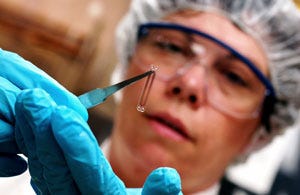How the CardioMEMS Device Was Designed
August 26, 2015
There has never been a device quite like the wirelessly powered CardioMEMS PA sensor. Designed to monitor pulmonary artery pressure data to help treat patients with NYHA Class III heart failure, the technology posed unique product development challenges.
Brian Buntz
Financial analysts have been upbeat about CardioMEMS technology, which was acquired by St. Jude Medical in 2014. Analyst firm Zacks states that the technology is expected to generate $70 million in sales this year.
And a report from EvaluateMedtech recently stated that the technology helped push up St. Jude Medical's share price in the first quarter of the year, and states that the technology could ultimately top $1 billion in peak sales.
|
The CardioMEMS device was the first technology of its kind. |
It was initially difficult, however, to prove to FDA that the benefits of such a novel device outweighed the risks, says Jason White, senior director, product development engineering for St. Jude Medical's CardioMEMS. "For devices such as a pacemaker or implantable defibrillator, the benefit is more straightforward to measure because therapy is the direct effect of the device," he says. "For the CardioMEMS HF System, the benefit is observed when the data provided by the system is incorporated by the physician into the care of the patient."
The company's Champion clinical trial was able to demonstrate a 37% reduction in heart failure hospitalizations over a 15 month average follow-up timeframe when physicians used the device to guide patient care. "The unique challenge was demonstrating that the benefits were achieved only as a result of the data provided by the system," White says.
Now that that the benefit of the technology is supported by strong clinical evidence, St. Jude may consider exploring other cardiology applications for it. The technology could be useful for monitoring chronic diseases that have a hemodynamic progression, such as hypertension, pulmonary arterial hypertension, respiratory disease, portal hypertension, and applications within congenital heart disease, White says. "We think this technology will also be useful to optimize settings for therapeutic implants such as cardiac resynchronization therapy and ventricular assist devices."
Another unique aspect of the technology is that it is powered by a radiofrequency (RF) electromagnetic field rather than a traditional battery. The RF field is "generated by an antenna positioned in a pillow that the patient lays on each time they take a reading," White says. "This powering method means the sensor does not require a battery and the approach to gathering the data does not require precise antenna alignment with the implanted sensor. The RF energy transfers effectively through air, clothing, and the patient's body to the depth of the implanted sensor."
White explains that St. Jude's CardioMEMS goal for future iterations of the technology is to continue to improve its use in helping to manage heart failure. "We expect technology advancement for heart failure patients could allow the measurement of additional parameters and improvement in monitoring capabilities," he says.
When asked to provide words of wisdom to other device firms that are exploring using MEMS technology in their products, White says: "A medical device with MEMS technology needs to be designed with the system in mind; there are significant requirements that are not specific to MEMS technology."
Learn more about cutting-edge medical devices at MEDevice San Diego, September 1-2, and MD&M Philadelphia, October 7-8. |
Brian Buntz is the editor-in-chief of MPMN and Qmed. Follow him on Twitter at @brian_buntz.
Like what you're reading? Subscribe to our daily e-newsletter.
About the Author(s)
You May Also Like



